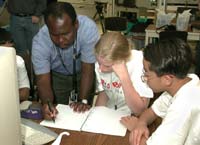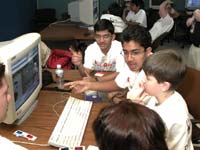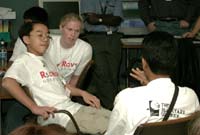|
 |
|
Intense discussion is part of planning for any scientific mission. |
|
Intense discussion, various viewpoints, chairs being scooted around,
slightly raised voices, and eventual consensus: just a typical meeting of
scientists in the lab; in this case a rover lab at NASA's Jet
Propulsion Laboratory.
The difference, though, was that this group was composed of students
from four countries around the world who were planning simulated
scientific tasks for exploring the surface of Mars. One of the targets they
chose for analysis was a rock that they nicknamed "Pebbles."
Only this rock isn't on the red planet; it is located in the JPL Mars Yard, an
outdoor test facility that approximates Mars terrain located away from the
rover lab. And after the mission, the students were able to visit
"Mars" and actually see the rover used to conduct the
exercise and "Mars rocks".
Student navigators selected by The Planetary Society as part of their
Red Rover Goes to Mars program recently visited JPL to participate in a
simulated mission operations exercise. They were able to experience the
drama and excitement of a mission to Mars "up close and
personal," as do scientists and other mission team members
currently preparing for the 2003 Mars Exploration Rovers mission.
 |
|
Mission planner Dr. Ashitey Trebi-Ollennu explains details for
science and engineering planning during planning for a simulated
mission by student navigators from the Red Rover Goes to Mars
program. |
|
From a simulated mission control room, the students put the Field
Integrated Design and Operations (FIDO) robotic rover through its paces
in the JPL Mars Yard. Operations focused on short distance driving,
trenching into soil using a FIDO wheel and taking images using a camera
on the FIDO robotic arm. Students were able to participate in the
process of characterizing exposed sediments using imaging and
spectroscopy. Using training prepared by The Planetary Society,
students had previously studied physics and geology and participated
in on-line exercises to prepare them to interpret what they would see
through the rover's sensors.
"It was interesting," said Dr. Eddie Tunstel, FIDO lead
engineer and JPL point-of-contact for the visit. "The discussions
were conducted just as rover mission scientists do here when planning
tasks. Their enthusiasm is great - I noticed many members of the FIDO
team dropping by just to observe the exercise."
On the first day of their three-day visit, students and their parents
toured JPL. The second day was taken up with an intensive short course
on using JPL's software used for remotely commanding FIDO. The third
day was devoted to the simulated mission.
Science planning and execution was led by Dr. Bob Anderson, scientist
for the rock abrasion tool on an upcoming rover mission, acting as flight
manager, and Dr. Ashitey Trebi-Ollennu, mission planner and FIDO control
systems engineer. Rover operations engineer Dr. Mark Powell, mission
uplink/downlink lead, kept very busy building command sequences for the
rover in response to students' decisions about what they wanted to
study and noted that they were easy to train in using the software.
 |
|
Shaleen Harlalka, 17, second from left, plans a career in science and
expects to attend either an Indian university or one of the top U.S.
universities with strong science programs. He also swims at the
national level, likes to read, and likes adventure. He was previously
a Student Scientist in the Red Rover program, before becoming a
Student Navigator. Others pictured are, from left, Bhushan Prakash
Mahadik, India, and Daniel Jan Hermanowicz, Poland. |
The JPL team kept the mission planning discussion on course, reminding
the student navigators of time and software/hardware constraints. They
provided guidance for potential science targets, but let the students make
the decisions on the scientific focus.
Trebi-Ollennu said, "We've had a fantastic three days with the
kids. These tests provided an exciting venue for the kids to apply verbal,
written, mathematical and computer skills to solve real-world problems.
This international experience also gives the kids a unique insight and
perspective as to how to work in a collaborative team of experts from
diverse disciplines and cultures, an invaluable asset as aspiring space
explorers."
While the student navigators were all scientific seriousness in the
mission room, excitement and high spirits prevailed on their visit to the
Mars Yard. They took pictures and got as close as possible to the rover,
asking questions and chattering about their experience. Too soon, it was
time to say goodbye to the rover and go back to the lab to
conclude the mission.
Anderson led the group in a discussion of what they had done and
what they had learned during the three days. The students agreed that
they had learned to work as a team, to collaborate, to support consensus
and they learned scientific procedures.
 |
|
Jacqui Hayes, a 17-year-old Australian, center, will start at the
University of Sydney in March, taking advanced science.
Always interested in science, one of her school projects as a
child was to wire her doll house with electricity. She says,
"I'd love to be part of the upcoming Australian space
industry." She's also interested in biotechnology and
genetics. This was her first trip to the United States, so she and
her parents have enjoyed visiting tourist venues. Also shown
is Kevin Hou, United States.
|
|
Students also commented that they had learned how helpless they
could feel when they couldn't get an image they wanted and couldn't do
anything about it, and when the answer they got was not what they
thought it would be.
"Sometimes a negative answer is the answer,"
Anderson told them. "Part of learning is that technology
doesn't always work."
Shaleen Harlalka, an Indian student, said "We're really lucky
for this entire experience."
The students and their countries are: Paul Nicholas Bonato, 17,
Australia; Avinash Chandrashekar, 12, India; Kimberly DeRose, 15,
United States; Shaleen Harlalka, 17, India; Jacqueline Cherie Hayes, 17,
Australia; Daniel Jan Hermanowicz, 11, Poland; Kevin Hou, 13,
United States; and Bhushan Prakash Mahadik, 15, India.
They were accompanied by Glenn Cunningham, retired JPL Mars
Global Surveyor project manager, Dr. Bruce Betts and Emily Lakdawalla
from the Planetary Society and teacher Charlie Lindgren (CK).
The Planetary Society, Pasadena, Calif., created the Red Rover Goes
to Mars project to give exceptional students worldwide a unique opportunity
to participate in performing real science using robotic rovers. Student
navigators were selected from well over ten thousand international contest
entrants, all of whom wrote journals chronicling their experiences
teleoperating LEGO rovers. The general public was also invited to
participate in the program through the
Red Rover Goes to Mars
International Art Competition, at http://planetary.org/rrgtm/artcontest.html ,
and the
Send Your Name to Mars
campaign, at http://spacekids.hq.nasa.gov/2003 .
Red Rover Goes to Mars grew out of the successful Red Rover, Red
Rover project. Red Rover, Red Rover allows classes of students to build their
own Mars rovers from LEGO bricks and guide them through simulated Mars
environments that they build. Students can also operate rovers built by
other classes over an Internet connection.
For more information about the
Red Rover Goes to Mars program,
please see http://planetary.org/rrgtm/index.html . For more information
about
NASA's Mars program, please
see http://marsprogram.jpl.nasa.gov . The
JPL home page is at http://www.jpl.nasa.gov .
|